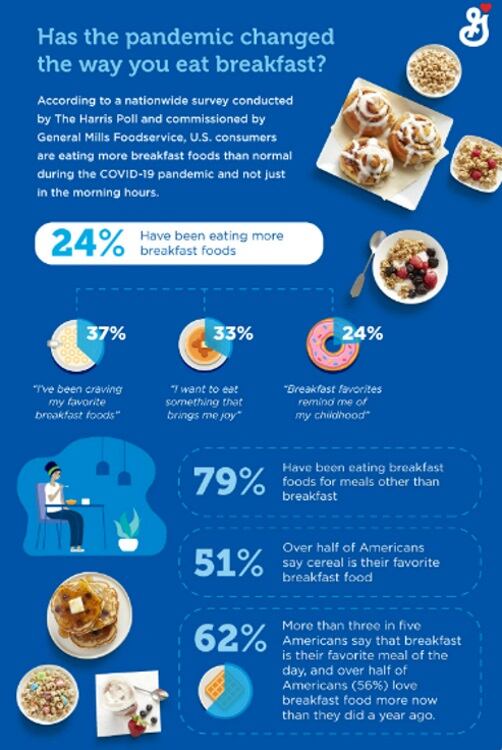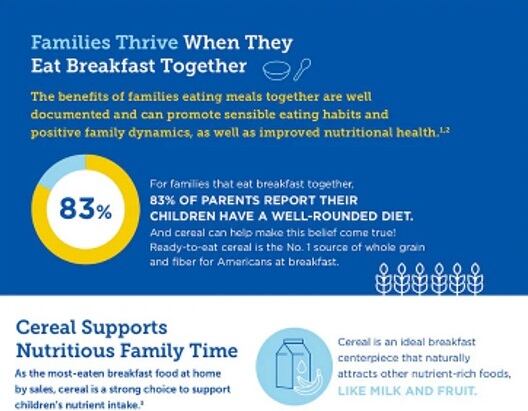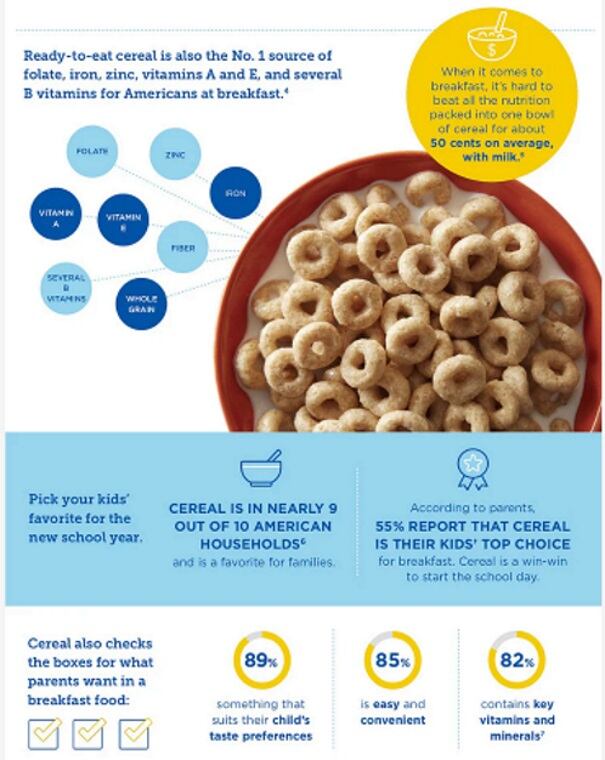A survey by Lucid in June/July 2020 commissioned by Big G’s cereal brands revealed 73% of US families with school-aged children were spending more time together around the breakfast table.
“Even in a challenging time, families are taking heart in the extra moments they have to share with their kids,” Amy Cohn, RD, senior manager of nutrition and external affairs for General Mills’ Cereal division, said on publishing the results.
“Cereal is a common denominator. While we know the school year may look different this fall, parents and kids can count on cereal to keep bringing them around the table together and helping to fuel their day.”

The benefits of sitting down to share a simple meal were highlighted in a 2010 study published in Pediatrics.
“The frequency of shared family meals is significantly related to nutritional health in children and adolescents,” wrote authors Amber Hammons and Barbara Fiese.
“Children and adolescents who share family meals three or more times per week are more likely to be in a normal weight range and have healthier dietary and eating patterns than those who share fewer than three family meals together. In addition, they are less likely to engage in disordered eating.”
On its website, Stanford Medicine Children’s Health concurred, noting “when a family sits down together, it helps them handle the stresses of daily life and the hassles of day-to-day existence. Eating together tends to promote more sensible eating habits, which in turn helps family members manage their weight more easily.”

Is inflation impacting healthy eating?
But just as we have climbed one mountain, so we come face to face with another, even larger, challenge – runaway inflation.
Families across the US – and indeed, the world – are feeling the impact, and 75% of parents are worried their offspring are not getting enough of the nutrients they need.
The research was conducted in August by The Harris Poll on behalf of General Mills among 1,000 parents of kids aged 12 or under.
Another survey a few weeks earlier among 1,285 parents of children under 18 found 65% are increasingly concerned about their ability to provide a ‘healthy’ breakfast. In fact, more than half of those surveyed believe it is only the wealthier families who can afford nutritious options for their family.
Sadly, this is essentially true. Foods that are not processed and have a good nutritional profile are typically more expensive per calorie than less healthy equivalents.
And in these times of keeping a sharp eye on our shekels, price is increasingly taking precedent over nutrition.

The gap between those with lower and higher incomes – along with the increasing number of consumers who find themselves falling into the lower group – is reflected in the increased use of food banks.
In Q1 2021 in the UK, 41% of those who are taking action to lessen expenditure and 38% of those who have cut all extraneous expenditure claimed their diet was still ‘very healthy’, but both of these scores dropped significantly to 33% and 26% respectively in Q1 2022.
Conversely, for the same period, this increased from 44% to 46% for the same period for those who are aware but not affected by economic problems.
Likewise, consumer research indicates the current environment is having a greater impact on the lower-income consumers, which traditionally spend a much larger percentage of their disposable income on food.
According to USDA data, US households with the lowest 20% of income spent 27% of it on food in 2020, versus only 7% among the 20% top income-earners. Furthermore, low-income households spend more on food types that have risen most in price, such as bread and cereals.
But with the squeeze, consumers who are less financially stable are more likely to cut meals (32%); limit portion sizes (30%); eliminate snacks (35%); and unwillingly make unhealthier choices. For those already struggling, the rapid price increases are forcing even tougher choices about what, when and how often to eat.
According to the McKinsey Institute for Black Economic Mobility, breakfast cereal, bakery and snack producers have a $340bn opportunity to give Black consumers equitable access to healthier foods.
For Black Americans, gathering around the breakfast table or for Sunday dinner is the centrepiece that binds families and communities. But while the function is common, equitable access is not and with Black consumer spend on food expected to grow 5% each year – a rate higher than the annual growth of the Black population – the stakes are high for producers who ignore this community.
Ukraine exacerbation
Food prices were on the boil even before the Russian invasion of Ukraine. According to the FAO, food prices spiked by 12.4% in March 2020 from February and by 33.6% compared to a year ago. Higher fuel prices is only making things worse.
The conflict has undoubtedly made things a lot worse. Pre-conflict, the bakery and cereal sector was forecasting a healthy 4%-6% growth and an overall gain of $167bn from 2020 to 2025, but this is now likely to change.

In fact, in May, Kellogg CEO Steve Cahillane said the breakfast cereal giant – which so far has essentially avoided hiking prices – is finally expecting to crumple amid worsening challenges, with inflation and the war playing a major role.
“The situation in Ukraine only accelerated cost inflation and exacerbated the global economy's bottlenecks and shortages. It also prompted us to suspend all shipments and investments into Russia and to identify new sources for certain ingredients,” said Cahillane.
Which is all very alarming to most consumers, especially with no relief in sight.
Cereal praise
The good news is that breakfast cereals are essentially packed with good things and don’t have to break the bank.
To punt the message, the Cheerios, Fibre One and Lucky Charms maker has initiated the Ce[Real] Deal campaign, partnering with registered dietitians to ‘sing’ cereal praise.
With danceable, sing-along content on social media (#ceREALdeal), the dietitians have been tasked to showcase how a nutritious start to the day doesn’t have to come with a high price tag.
“Parents can feel relief knowing that a nutritious breakfast doesn’t have to be complicated or break the bank,” said Amy Cohn, registered dietitian and senior nutrition manager at General Mills.
“The simple act of providing kids with cereal for breakfast is one of the easiest and most affordable ways to make a nutritious choice for your child. Many cereals deliver whole grain, fibre, vitamins, and minerals all in one bowl, which are not always easy to find in other breakfast choices.”
Nutrition research shows cereal eaters tend to take in more calcium, vitamin D and fibre than non-cereal eaters; while, on average, a bowl of General Mills’ Big G cereal with milk costs about 50 cents per serving, according to Nielsen sales data for July 2022.

“As a mom and registered dietitian, I’m on a mission to help alleviate the guilt that parents feel when it comes to feeding their kids well,” said Nicole Rodriguez, RDN, NASM-CPT and founder of Enjoy Food Enjoy Life, which is participating in the campaign.
“The truth is, you don’t need to choose between ‘easy’ and ‘nutritious’ when it comes to giving your kids a breakfast they’ll love. Cereal truly is the real deal in delivering the delicious and affordable nutrition that kids will happily eat.”
Studies:
Is frequency of shared family meals related to the nutritional health of children and adolescents?
Authors: Hammons, Amber J and Fiese, Barbara H.
Pediatrics vol. 127,6 (2011): e1565-74.
Dietary Guidelines for Americans
US Department of Agriculture and US Department of Health and Human Services
2020-2025. 9th Edition.





